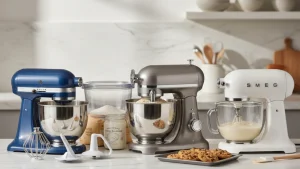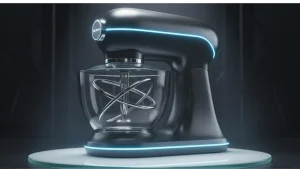Stand Mixer Recommendations: If you’ve spent any time baking, you know the magic of a stand mixer. I’ve been through my fair share of mixers, from tiny handheld whisks to full-sized powerhouses, and I’ll admit— finding the right one can feel like searching for buried treasure. But here’s the good news: once you find a mixer that fits your needs, it makes baking a breeze. In this guide, I’m going to walk you through everything I’ve learned about stand mixers: what to look for, how they perform on different tasks, and which models are worth your money. By the end, you’ll know exactly which mixer suits your style, whether you’re whipping cream for one cake or kneading pizza dough for a dinner party.

Here’s what you’ll learn in this post:
-
How stand mixers work
-
Why attachment size and fit matter
-
Ease of use and cleaning tips
-
Stability and “walking” issues
-
Choosing the right size for your needs
-
My top stand mixer picks and why I love them
How Stand Mixers Work: The Basics
All stand mixers have a bowl attached to a sturdy base. Some have heads that lift, others lift the bowl itself. The key is the attachment—usually a whisk, paddle, or dough hook—that spins in what’s called “planetary action.” In simpler terms, it moves around the bowl while spinning, making sure every ingredient gets mixed evenly. Think of it like the Earth orbiting the Sun while spinning on its own axis—ingredients get the full treatment.
Why does this matter? Well, a mixer that mixes unevenly leaves lumps of butter in your cake or unincorporated flour in your dough. I’ve had my share of lumpy mishaps, and trust me, you don’t want that.
Size and Fit of Attachments: A Small Detail That Makes a Big Difference
During my tests, I noticed that larger attachments that hugged the sides and bottom of the bowl performed the best. Mixers with small or poorly designed attachments often left ingredients stuck at the edges, forcing me to stop and scrape repeatedly.
For example, a friend’s budget mixer couldn’t properly cream butter and sugar for a pound cake, leaving parts of the mixture untouched. I had to intervene constantly, which defeated the purpose of having a stand mixer in the first place.
The takeaway? When choosing a mixer, look for attachments that reach the bowl’s edges. It sounds simple, but it saves so much time and frustration.
Ease of Use: Shouldn’t Feel Like Rocket Science
I’m a big fan of simple controls. The last thing I want while baking is to wrestle with a touchscreen interface or confusing knobs. My favorite mixers have clear speed dials, buttons that make sense at a glance, and bowls that are easy to lift and attach.
Handles on the bowls are underrated. You might think it’s a small detail, but being able to hold a heavy, dough-filled bowl with one hand while scraping it with the other is a game-changer. I’ve tested mixers where the bowl had no handle, and let’s just say, it was not pretty.
Stability Matters: Your Mixer Should Stay Put
Nothing frustrates me more than a mixer that “walks” across the counter. Heavy mixers naturally stay in place, but lighter models can slide around while kneading thick dough. Some mixers try to fix this with suction cups, but in my experience, these are often a hassle to move or reposition.
If you’re making pizza dough or anything that requires serious kneading, stability is crucial. Otherwise, you’ll spend more time chasing the mixer than actually baking.
Choosing the Right Size for Your Needs
Stand mixers come in different sizes, and picking the right one depends on your baking habits.
-
Casual bakers: If you only bake occasionally, a smaller mixer like the KitchenAid Artisan Mini Stand Mixer works perfectly. It’s compact, lightweight, and handles most basic tasks.
-
Regular bakers: A mid-sized mixer, such as the KitchenAid 5-Quart Tilt-Head Stand Mixer, is great for everyday use. It can handle cakes, cookies, and bread dough with ease.
-
Heavy-duty bakers: For frequent bakers or those making large batches, a larger bowl-lift mixer like the KitchenAid 7-Quart Stand Mixer is ideal. It’s powerful, roomy, and perfect for multiple loaves of bread or big cakes.
Tests I Use to Pick the Best Mixers
I don’t just go by specs—I test each mixer in real baking scenarios:
-
Whipped Cream Test – One cup of heavy cream whipped to see how well small amounts are handled.
-
Pound Cake Test – Evaluates mixing, creaming, and emulsification with butter, sugar, and eggs.
-
Pizza Dough Test – Kneads stiff and sticky dough to check for dough hook performance.
-
Ciabatta Test – Long kneading test for sticky, high-hydration dough.
-
Ease of Cleaning – I hand-wash all attachments to see how easy it is to clean.
This approach ensures I’m recommending mixers that actually perform in the kitchen, not just on paper.
My Favorite Stand Mixers
KitchenAid 7-Quart Bowl Lift Stand Mixer
This mixer is a powerhouse. It handled whipped cream, pound cake batter, and pizza dough effortlessly. I loved the multiple paddles, the large handle on the bowl, and the redesigned hub that’s easy to remove. Stainless steel attachments resist chipping, and the bowl is surprisingly quiet during operation.
Downside: It’s heavy, and seating the bowl can take a little practice.

KitchenAid 5-Quart Tilt-Head Stand Mixer
Perfect for casual bakers, this mixer is easier to store and lightweight without sacrificing power. It has intuitive controls and handles most baking tasks effortlessly.
Ankarsrum Stand Mixer
This one has a learning curve—you add ingredients differently—but once you get used to it, it handles large dough batches like a champ.
KitchenAid Artisan Mini Stand Mixer
Great for small kitchens or occasional baking. Compact and efficient, it’s ideal for cupcakes, cookies, and small batches.
Tips for Using Your Stand Mixer
-
Scrape Often: Even with well-fitting attachments, it’s a good idea to scrape the bowl occasionally to ensure everything is mixed evenly.
-
Don’t Overload: Big batches are tempting, but overloading can strain the motor and affect results.
-
Keep it Clean: A clean bowl and attachments prevent leftover flavors from showing up in your next batch.
FAQs: Stand Mixer Recommendations
1. Which stand mixer is best for casual bakers?
I’d go with the KitchenAid 5-Quart Tilt-Head Stand Mixer. It’s compact, powerful, and handles most everyday baking without taking over your counter.
2. Do I need a large stand mixer if I bake occasionally?
Not at all. Smaller mixers like the Artisan Mini are perfect for cupcakes, cookies, and small batches. Big mixers are only necessary for frequent or heavy-duty baking.
3. Can all stand mixers handle bread dough?
Most can, but mixers with strong motors and well-fitted dough hooks—like the Ankarsrum—make kneading thick or sticky dough much easier.
4. Are bowl handles really that important?
Absolutely. Being able to hold a heavy, dough-filled bowl while scraping it is a small detail that saves a lot of frustration. I’ve tested mixers without handles, and it’s a workout I didn’t sign up for.
5. Why does my stand mixer “walk” on the counter?
Lighter mixers can slide while kneading stiff dough. Heavier mixers usually stay put. Some models use suction cups, but in my experience, they can be annoying to move or adjust.
6. How should I clean my stand mixer?
Detach the bowl and attachments. Hand wash or use the dishwasher if safe. Wipe down the mixer body with a damp cloth. Clean attachments prevent flavors from carrying over to the next batch.
7. How do I know what size mixer to buy?
It depends on your baking habits:
Final Thoughts
Stand Mixer Recommendations: Choosing a stand mixer comes down to your baking habits, kitchen space, and budget. A heavy-duty, bowl-lift mixer is perfect for serious bakers, while a compact tilt-head mixer is enough for casual use. Focus on stability, attachment fit, ease of use, and bowl comfort.
For me, the KitchenAid 7-Quart Bowl Lift Stand Mixer stands out as the most reliable all-around choice. But whatever mixer you choose, a good stand mixer will save you time, effort, and frustration, leaving you more energy to enjoy your baked creations (and maybe even lick the bowl without guilt).